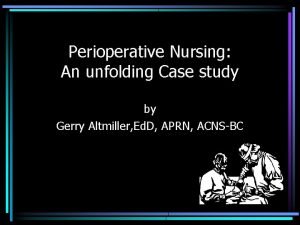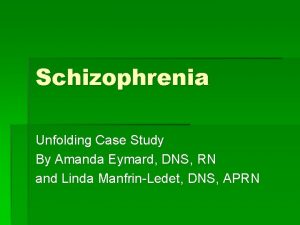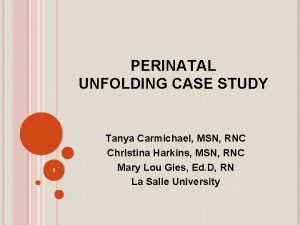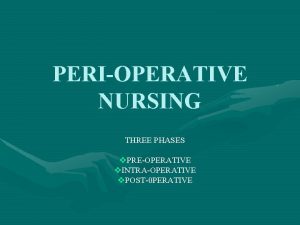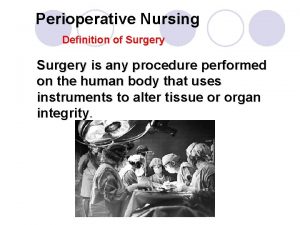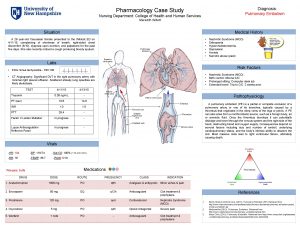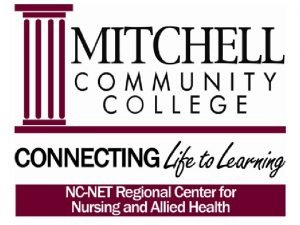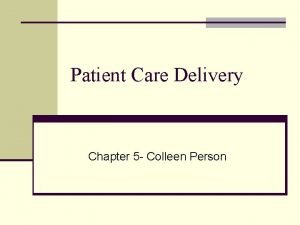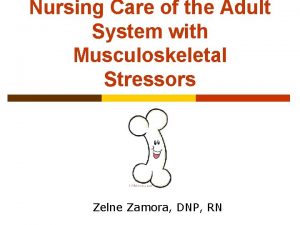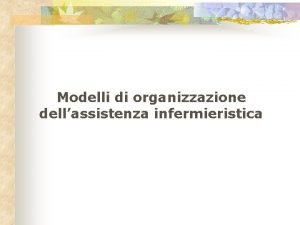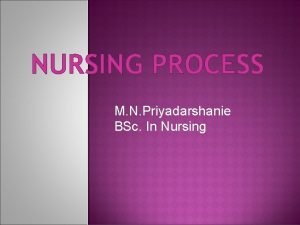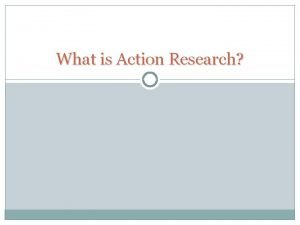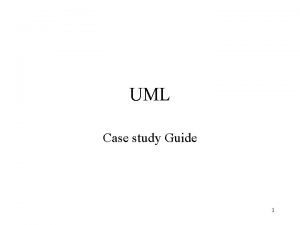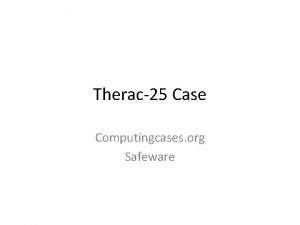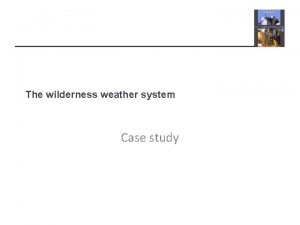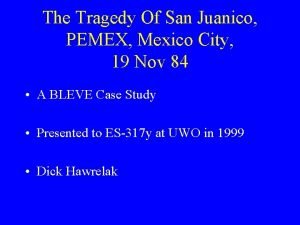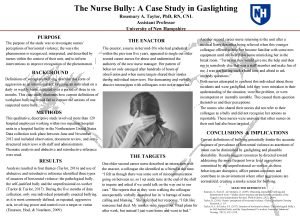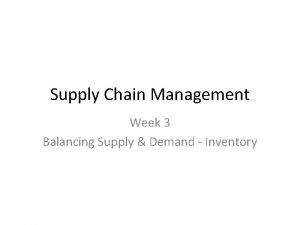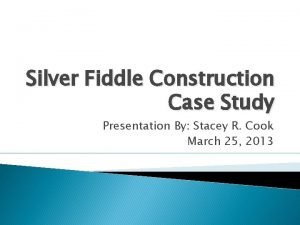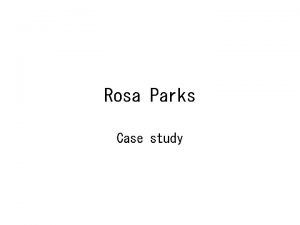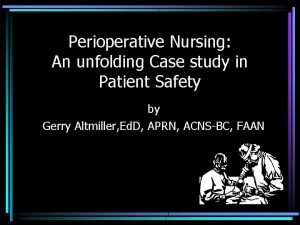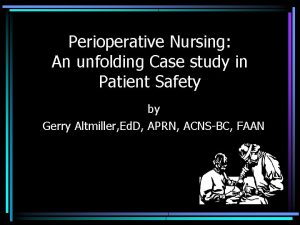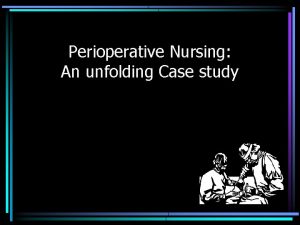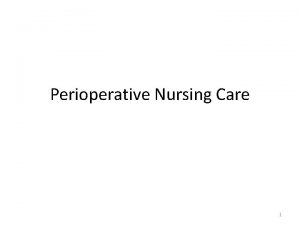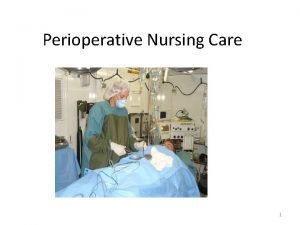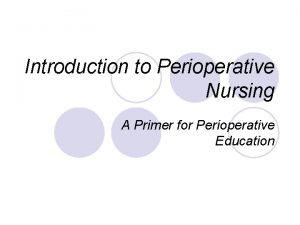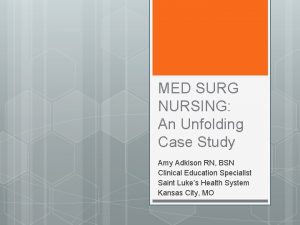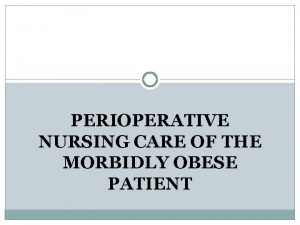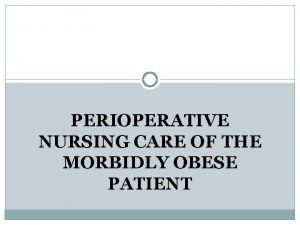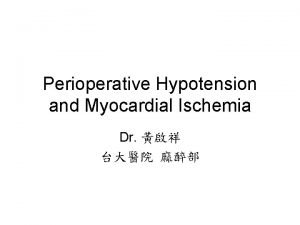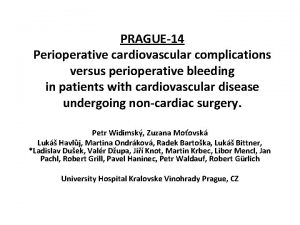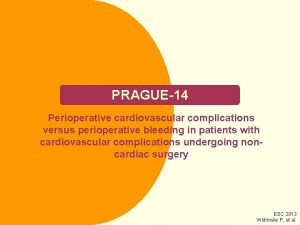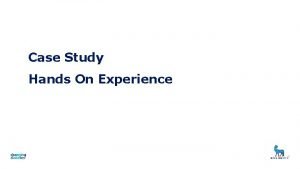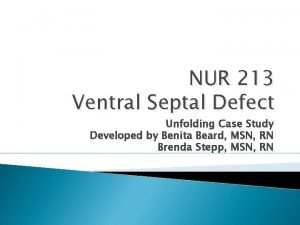Perioperative Nursing An unfolding Case study in Patient


































































- Slides: 66

Perioperative Nursing: An unfolding Case study in Patient Safety by Gerry Altmiller, Ed. D, APRN, ACNS-BC, FAAN

The Case: ü John Egan, 53. ü Hx of Type 1 diabetes mellitus, cigarette smoking 40 pack years, CAD, and PVD. ü Six weeks ago, he developed a wound of his left heel which measured 4 cm by 2 cm when he discovered it. Despite IV antibiotics and chemical debridement, the wound developed a gangrene infection. He is scheduled for a BKA of the left lower extremity tomorrow at 10: 00 am. ü His meds include daily insulin, aspirin 325 mg/day, Pletal 100 mg BID. ü He has an advanced directive and NKDA.

Identify the priority nursing care for Mr. Egan: Identify what he needs done before he can go to surgery safely.

Priority Care to maintain patient safety ü Complete preoperative testing/preparation ü Maintain normal glucose levels ü Ensure informed consent ü Ensure correct surgical site ü Prevent postoperative infection ü Complete preoperative teaching to prevent complications ü Address psychological comfort

What preoperative testing is appropriate for Mr. Egan?

Pre-surgical Screening Tests 1. Chest x-ray 2. Electrocardiogram for > 40 yrs 3. Complete blood count 4. Electrolyte levels 5. Urinalysis 6. X-ray left lower extremity

When completing a medication reconciliation for Mr. Egan the evening before surgery, what in the following orders cause the nurse concern? • Insulin 6 u Regular with 15 u NPH subcutaneous q am. • Aspirin 325 mg PO qd. • Cilostazol (Pletal) 100 mg PO BID • Lorazepam. 5 mg IVP on call to OR in AM. – The Joint Commission Do Not Use Abbreviation List

ü Insulin 6 u Regular with 15 u NPH subcutaneous q am. (High Alert Med) (NPO after Midnight) (u s/b units) ü Aspirin 325 mg PO q d. (Do not use abbrev) (bleeding potential) ü Cilostazol 100 mg PO BID (bleeding potential) ü Lorazepam. 5 mg IVP on call to OR in AM. (s/b 0. 5 mg)

Dr. Damon is Mr. Egan’s surgeon and Dr. Riley is Mr. Egan’s anesthesiologist. Both come to see him and discuss the surgery the evening before. How does the nurse ensure informed consent? What must the patient consent to for the procedure to be done?

Informed Consent for Surgery & Blood Transfusion 3 requirements: 1. Adequate disclosure of diagnosis-purpose, risks, and consequences of treatment, probability of success, prognosis if not instituted 2. Understanding & comprehension -patient must be drug free prior to signing consent 3. Consent given voluntarily -patient must not be persuaded or coerced to undergo the procedure

Informed Consent Information ü Description of procedure and alternative therapies ü Underlying disease process and its natural course ü Name and qualifications of person performing procedure ü Explanation of risks and how often they occur ü Explanation that patient has the right to refuse treatment or withdraw consent

Informed Consent

Informed Consent and the Law ü Must be 18 years old or emancipated minor ü Parent signs for dependent children ü Must be deemed competent to sign own consent ü Must be alert & oriented; Consent may not be signed by patient after receiving narcotics or sedatives ü Not necessary if threat to life and patient or legally authorized person unavailable-2 physicians sign ü Nurses role: advocate, witness, appropriate person signs

What does it mean that Mr. Egan has an advance directive? How will it apply to his surgical procedure?

Advance Directives ü Living wills – Patient may be a full code for 24 hours following surgery – Signed form releases liability – Allows family to know patient wishes in the event of serious intra-operative complication ü Durable power of attorney for healthcare ü POLST

POLST ü Physician Orders for Life. Sustaining Treatment (POLST) • a portable, legal document that is the result of conversations between patient and health care representative, providing orders for end-of-life care for those with serious illnesses

During the admission assessment, the nurse questions Mr. Egan to determine if he has a latex allergy or sensitivity. Why is this essential to the patient’s safety? What symptoms would the nurse question Mr. Egan about in order to determine this?

Latex Allergy/Sensitivity ü At Risk: üGenetic predisposition üHx of multiple surgeries – Children with spina bifida – Urogenital abnormalities – Spinal cord injuries üAllergies, asthma üHealth care professionals

Latex Allergy/Sensitivity S&S üUrticaria üRhinorrhea üBronchospasm üCompromised respiratory status üCirculatory collapse & Death Management üIdentify those at risk üLatex free environment üLatex free equipment

Mindfulness Preventing complications of surgery is an important part of all surgical patient’s care. What pre-operative teaching does Mr. Egan require in order to prevent complications? Make a list

Preventing Patient Injury Through Preoperative Teaching ü Surgical events and sensations ü Surgical site preparation -Cleaning with Chlorhexidine wipes ü Pain management ü Physical activities ü Cough & deep breathing ü Incentive spirometry ü Leg exercises ü Turning in bed

Mr. Egan is very restless the evening before. He verbalizes to his wife that he is “scared to death” and worried about losing his foot. She asks the nurse what can be done to help him. How will the nurse address the psychological comfort of Mr. Egan?

Nursing Interventions to Meet Psychological Needs of Surgical Patients ü Establish therapeutic relationship and allow verbalization of fears and concerns. ü Use touch to demonstrate genuine empathy and caring. ü Be prepared to respond to questions about surgery and the postoperative and rehabilitative experience. ü Ensure a sleep aid is ordered for the patient for the evening before surgery.

• On the morning of the surgery, the OR calls for Mr. Egan to be brought to the Preoperative Holding Area. • What are the responsibilities of the nurse caring for Mr. Egan at this time?

Nursing Responsibilities during immediate preoperative period ü Accurate Identification of Mr. Egan – 2 patient identifiers ü Signed consent forms are in the chart ü Time of last oral intake for patient recorded ü Patent IV with. 9 NSS infusing at 100 m. L/hr as ordered ü Mr. Egan voids before preoperative medications ü Preoperative dose of Ativan 0. 5 mg IV given once on stretcher ü OR Checklist completed and on the front of the chart ü Safe transport to OR via stretcher with side rails up – Deliver preoperative antibiotic with patient ü Psychosocial support for Mr. Egan and his family

Preoperative Checklist • Lists requirements before patient goes to OR ü diagnostic tests complete ü preoperative medication given ü VS • Documents safety data ü ID band in place; 2 identifiers ü Jewelry removed ü Last void ü Dentures removed ü Informed consent verified ü Patient Allergies listed

Effective Standardized Communication SBAR – Situation – Background – Assessment – Recommendation

In the Preoperative Holding Area, Mr. Egan is delivered into the care of the holding room nurse. Using SBAR technique, discuss the safe hand-off of the patient between the unit nurse and the Holding Area Nurse.

Patient Safety Dr. Damon meets with Mr. Egan in the Preoperative Holding Area. What final safety checks will be made at this time?

PREOPERATIVE HOLDING AREA Dr. Damon meets with Mr. Egan in the OR Holding Area. What final safety checks will be made at this time? ü Accurate identification of patient, surgical procedure, & site – Done in holding room with surgeon present – Surgeon initials site – Pt needs to be able to hear and communicate

Mr. Egan is transferred to OR Suite 3 where he is transferred onto the table. Skin assessment reveals 2 cm reddened area on right heel. What action should the OR nurse take?

While Mr. Egan is in the Operating Room, what considerations will be taken to ensure Mr. Egan’s safety in the OR?

Time Out TIME OUT IN ACTION

Intra-operative Safety ü Personal Protective Equipment available and in use by staff. ü Safe patient transfer and positioning/pressure point padding ü Maintenance of sterile technique ü Continuous patient monitoring ü Instrument count ü Sponge count ü Antibiotic as per protocol ü Breaks for personnel with appropriate hand-off communication

Safe Communication: AORN Hand-off Guidelines ü Individualized patient report ü Conversation on patient only; minimize distractions ü 1 person speaks at a time ü Use supporting documentation ü Equipment needs identified ü Opportunity for questions Safe Communication Strategies ü Use read-back methods ü SBAR ü Standardized checklists, tools, & protocols ü SURgical Patient Safety System (SURPASS) Checklist

Post-operatively, Mr. Egan awakens and is extubated; he is transported to the Post Anesthesia Care Unit (PACU) by the CRNA and OR circulating nurse. Surgical time 2 hr 20 mins Mr. Egan is Postoperative communication: discharged back to Unexpected Complication: his telemetry unit EBL is 600 m. L- normal is 300 bed after a 2 hour IV R antecubital infusing. 9 PACU stay. Using NSS-100 m. L/hr SBAR communication Post operative labs are drawn strategy, provide a and sent; capillary glucose=144 safe hand-off of Mr. VS BP=122/84 P=72, RR 20 R/A, Egan to the unit T 97. 4 F nurse? PCA-Morphine Surgical dressing clean Hemovac drain at site

Mr. Egan’s postoperative medication orders include the following: ü Insulin 6 units Regular insulin with 15 units NPH insulin sub-cutaneous in am. ü PCA Syringe: Morphine Sulfate 1 mg/m. L -0. 1 m. L bolus q 5 mins up to 12 times hourly. ü Ketorolac 30 mg IVP q 6 hour for breakthrough incisional pain.

After receiving report, the med-surg unit nurse escorts Mr. Egan to his room via stretcher. He is drowsy but arousable. The unlicensed assistive personnel helps the nurse in transferring Mr. Egan into his bed. What post-operative assessments and immediate post-operative interventions should be performed for Mr. Egan?

Postoperative Assessments and Interventions ü Vital signs ü Other tubes ü Continuous Pulse ox ü Comfort ü Telemetry monitoring ü Position and safety ü Color and temperature of ü Report on fluid intake, skin output and estimated blood loss (EBL) ü Level of consciousness ü Monitor lab values ü Intravenous fluids ü Surgical site managementü NPO until bowel sounds return ü Drain-hemovac

While checking Mr. Egan’s surgical site, the nurse notices sanguineous drainage saturating the dressing. What actions should the nurse take?

In caring for Mr. Egan, the nurse recognizes that the highest priority in the post-operative phase is the prevention of complications. What complications should the nurse be mindful of following general anesthesia and a below the knee amputation (BKA)? ü Remember Mr. Egan is a smoker, has heart disease and diabetes type 1 as well as PVD

Preventable Postoperative Complications ü Pain ü Hemorrhage ü Hypovolemic Shock ü Thrombophlebitis-DVT ü Pulmonary embolus ü Fluid Overload ü Atelectasis ü Pneumonia ü Airway Obstruction ü Surgical site infection (SSI)

What interventions must the nurse implement to prevent respiratory complications?

Interventions to Prevent Respiratory Complications ü Monitoring vital signs ü Deep breathing ü Coughing ü Incentive spirometry ü Turning in bed; OOB to chair ü Ambulating ü Maintaining hydration ü Avoiding positioning that decreases ventilation ü Monitoring responses to narcotic analgesics

Preventing Atelectasis

Splinting wound while coughing following abdominal surgery

What interventions must the nurse implement to prevent cardio-vascular complications?

Interventions to Prevent Deep Vein Thrombosis (DVT) ü OOB to chair early and often ü While on bed rest change position frequently ü Leg exercises non-operative side: dorsiflex, rotate ankle ü TED hose ü Intermittent compression boot ü Prophylactic SC heparin BID

Leg Exercises to Prevent Venous Stasis

What interventions must be taken to prevent surgical site infections?

Surgical Site Infection Prevention Bundle ü Appropriate use of prophylactic antibiotics ü Appropriate surgical site cleaning and hair removal before surgery – No shaving; use clippers when necessary ü Maintaining post-op glycemic control <200 ü Maintaining normal body temperature http: //www. ihi. org/resources/Pages/Changesto. Prevent. HAIs. aspx

While the nurse is on the phone with the lab, Mrs. Egan comes to the nurse’s station to tell the nurse that Mr. Egan is complaining of pain in his left foot. The nurse goes to Mr. Egan’s room to assess and determines he is having phantom limb pain. The nurse goes to the medication dispenser and selects a morphine 2 mg vial. The nurse draws the contents up in a needleless syringe. While walking to Mr. Egan’s room, the nurse stops and takes a time out. What does the nurse discover?

What is the nursing responsibility for this near miss? What is the red rule regarding medication administration?

What is the nursing responsibility for this near miss? ü Discard 2 mg of morphine with a witness ü Medicate Mr. Egan with the correct medication dose ü Complete incident/occurrence report ü Report near miss to immediate supervisor What is the red rule regarding narcotic administration? Never administer medications without reviewing MAR first; 3 checks of medication

Incident/Occurrence Reports ü Used to document any unusual occurrence that results in or has potential to result in harm to a patient, employee, or visitor üShould not be referred to in nursing notes üUsed for quality improvement to identify risks üRecords facts about an incident in case of litigation üMay be used in court as evidence

Laboratory personnel call the med-surg unit to report a critical lab value. The nurse answers the phone. What is the procedure to be followed for a critical lab value? Which of the following does the nurse identify as abnormal? Calcium 9. 7 Na 149 Magnesium 1. 8 Chloride 99 Phosphorus 3. 8 Glucose 186 Potassium 5. 4 Carbon Dioxide 25 BUN 30 Creatinine 1. 1 Hemoglobin 16. 2 Hematocrit 48%

Critical Lab Values Na 149 Chloride 99 Glucose 186 Potassium 5. 4 Carbon Dioxide 25 BUN 30 Creatinine 1. 1 Calcium 9. 7 Magnesium 1. 8 Phosphorus 3. 8 Hemoglobin 16. 2 Hematocrit 48%

What could be possible contributing factors to the lab abnormalities? What treatments would be most appropriate to correct the abnormalities? Using SBAR, call the surgical resident to address the critical lab values. Na 149 Chloride 99 Glucose 186 Potassium 5. 4

Later that evening, the nurse is called to the phone for an inquiry about Mr. Egan. The caller identifies herself as Mr. Egan’s sister. She wants to know his condition. What should the nurse tell the caller?

Confidentiality ü Protect & maintain privacy of all patient information whether spoken, written or saved in computer ü Includes confirmation that a patient is admitted to institution ü Health Insurance Portability and Accountability Act (HIPAA) – Disclosure requires signed authorization from patient

HIPAA Permitted Disclosure Incidental Disclosure ü Public health activities for infectious disease or danger ü Law enforcement and judicial proceedings ü Deceased individuals ü Use of sign-in sheets ü Overheard conversation provided attempt at privacy made ü Use of White boards ü X-ray light boards seen by passers-by ü Calling out names in waiting room ü Leaving appointment reminders on voicemail

The nurse is completing a pre-operative checklist for a 27 year old female scheduled for a bowel resection. Which of the following interventions must be done prior to this patient being sent to the OR? Select all that apply. a. Operative consent signed b. Allergy and ID bands in place c. Removal of gown d. Removal of nail polish e. Removal of jewelry f. Evidence of advanced directive g. Completed H & P h. EKG i. Anesthesia consent signed j. Results of preoperative diagnostic tests in chart

Question An 18 year old patient who is unconscious and hypotensive and who has sustained serious injury in an MVA in brought to the ED via ambulance. Which is true of the treatment for this patient? a. Next of kin needs to be notified prior to treatment beginning b. Advanced directive and durable power of attorney should be reviewed prior to treatment c. The life-threatening injuries warrant immediate emergent treatment d. The client can be treated after consent is given

Question Which of the following measures should be taken to prevent surgical site infection in a patient that has had abdominal surgery? Select all that apply. 1. administer prophylactic antibiotic as ordered 2. splint abdominal incision for coughing and deep breathing 3. have patient clean himself with chlorhexidine wipes the morning of surgery 4. maintain a blood glucose less than 250 mg/dl 5. maintain a normothermic body temperature within one hour of surgery

References 1. Altmiller, G. (2018). QSEN and nursing education: Medication reconciliation. Nurse Educator. 43(3): 111. 2. Altmiller, G. (2008). Peri-operative Nursing: An Unfolding Case Study. Retrieved from: http: //qsen. org/peri-operative-nursingan-unfolding-case-study/ 3. Cronenwett L, Sherwood G, Barnsteiner J, Disch J, Johnson J, Mitchell P, Sullivan DT, Warren J. Quality and safety education for nurses. Nurs Outlook. 2007; 55(3): 122 -131. 4. Institute for Healthcare Improvement. Changes to prevent healthcare associated infections. Retrieved from: http: //www. ihi. org/resources/Pages/Changesto. Preve nt. HAIs. aspx 5. Weike K. & Sutcliffe K. (2001) Managing the unexpected. Assuring high performance in an age of complexity. Jossey. Bass: San Francisco, CA

QUESTIONS?
 Perioperative case study
Perioperative case study Unfolding clinical reasoning case study
Unfolding clinical reasoning case study Schizophrenia unfolding case study answers
Schizophrenia unfolding case study answers Bubblehep
Bubblehep Phases of perioperative nursing
Phases of perioperative nursing Define perioperative nursing
Define perioperative nursing The kf case study
The kf case study Unfolding in vlsi signal processing
Unfolding in vlsi signal processing Tata letak
Tata letak Photodissociation
Photodissociation Metin2ü
Metin2ü Best case worst case average case
Best case worst case average case Pulmonary embolism case study
Pulmonary embolism case study Hip fracture case study nursing
Hip fracture case study nursing Fbi virtual case file case study
Fbi virtual case file case study Patient 2 patient
Patient 2 patient Canadian perioperative guidelines
Canadian perioperative guidelines Intraoperative care definition
Intraoperative care definition Lying positions in nursing
Lying positions in nursing Nursing care plan of cataract
Nursing care plan of cataract Nursing interventions for ocd patients
Nursing interventions for ocd patients Meeting patient expectations in nursing
Meeting patient expectations in nursing Define modular nursing in management
Define modular nursing in management Primary nursing vs total patient care
Primary nursing vs total patient care Nursing management of cerebral palsy
Nursing management of cerebral palsy Disuse syndrome
Disuse syndrome Example of community health nursing diagnosis statement
Example of community health nursing diagnosis statement Nursing process in psychiatric nursing
Nursing process in psychiatric nursing Differenza tra primary nursing e case manager
Differenza tra primary nursing e case manager Nursing care plan case scenario
Nursing care plan case scenario Difference between short case and long case
Difference between short case and long case Average case for binary search
Average case for binary search Case western reserve university case school of engineering
Case western reserve university case school of engineering Bubble sort best case and worst case
Bubble sort best case and worst case Bubble sort best case and worst case
Bubble sort best case and worst case Bubble sort best case and worst case
Bubble sort best case and worst case The ambiguous case for the law of sines
The ambiguous case for the law of sines Zara technology case study
Zara technology case study Yelp case study presentation
Yelp case study presentation Swot analysis of whole foods
Swot analysis of whole foods Action research vs case study
Action research vs case study Volkswagen of america: managing it priorities
Volkswagen of america: managing it priorities Valuation of plant and machinery
Valuation of plant and machinery Phil stephens villanova
Phil stephens villanova Starbucks foreign direct investment
Starbucks foreign direct investment Case study 11
Case study 11 Uml case study
Uml case study Illustrative case study example
Illustrative case study example Tuna for lunch case study answer key
Tuna for lunch case study answer key Tuna for lunch case study
Tuna for lunch case study Rainforest case study
Rainforest case study Supermarket seo case study
Supermarket seo case study Threats to biodiversity a case study of hawaiian birds
Threats to biodiversity a case study of hawaiian birds Mount st helens plates involved
Mount st helens plates involved Therac-25 case study
Therac-25 case study A wilderness weather station case study
A wilderness weather station case study San juanico mexico city
San juanico mexico city Gaslighting case study
Gaslighting case study The effects of coyote removal in texas
The effects of coyote removal in texas Semi structured questionaire
Semi structured questionaire Spend analysis case study
Spend analysis case study Telegram case study
Telegram case study Swanage bay facts
Swanage bay facts Safety stock formula
Safety stock formula Silver fiddle construction
Silver fiddle construction Flair furniture company linear programming
Flair furniture company linear programming Rosa parks case study
Rosa parks case study
